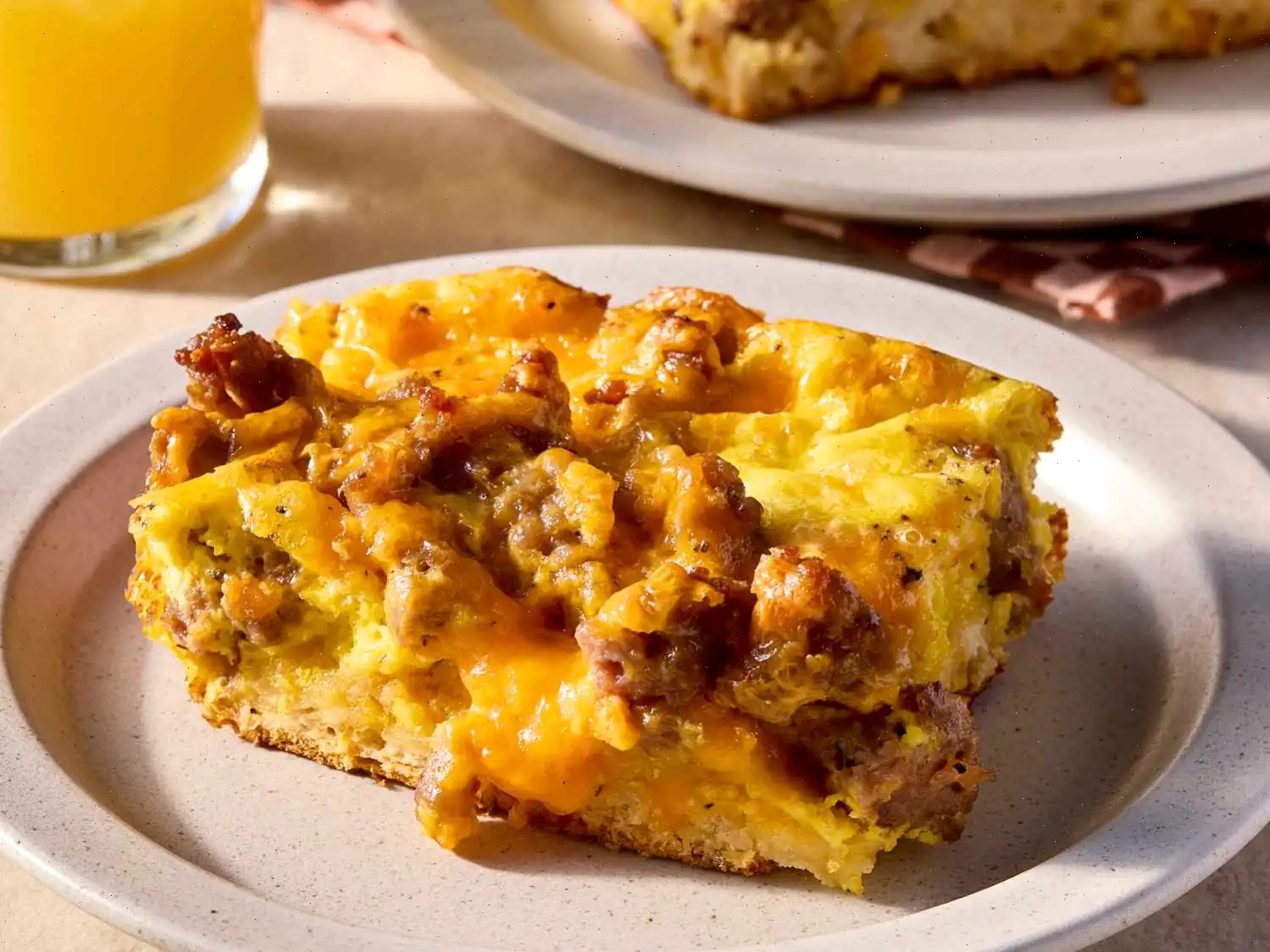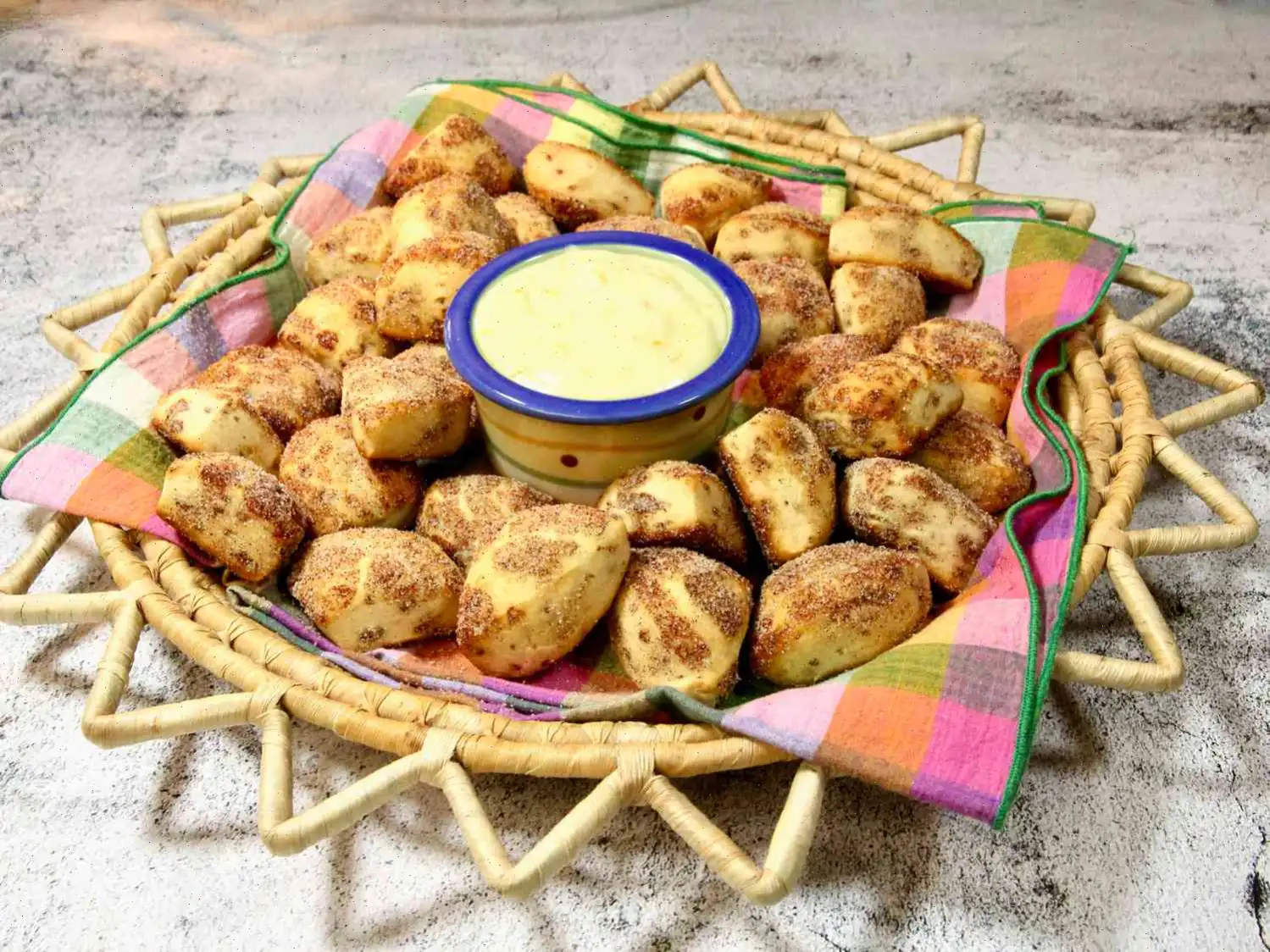
Baked Phyllo-Wrapped Feta with Honey Recipe
Frozen, ready-to-use phyllo dough is a fantastic shortcut in the kitchen. With just a few simple steps, you can create stunning pastries that look like they took hours to prepare. All you need is some melted butter, a little brushing, a flavorful filling, and a quick bake. The result? Crispy, golden-brown perfection every time. The trick is balancing the amount of dough and filling so that the pastries remain deliciously crisp but not overly dry. Heres a straightforward method to master this delicate balance. Enjoy!
Ingredients
- 1 (7-ounce) block feta cheese
- 1 large egg
- 2 tablespoons melted butter
- 2 tablespoons olive oil
- 4 (13x18-inch) sheets frozen phyllo dough, thawed
- 1 tablespoon sesame seeds
- 4 tablespoons honey
Directions
Step 1: Preheat your oven to 425F (220C). Line a baking sheet with a silicone baking mat, such as Silpat.
Step 2: Cut the block of feta cheese in half. Then, stand each half on its side and slice down into two pieces. You should end up with four pieces of feta, each about the same size.
Step 3: In a small bowl, whisk together the egg, melted butter, and olive oil until fully combined.
Step 4: Lay two sheets of phyllo dough flat on your counter. Brush the dough evenly with the egg mixture, covering around 75% to 80% of the surface.
Step 5: Place two pieces of feta side by side about 4 inches from the bottom edge of the dough.
Step 6: Fold the bottom edge of the dough over the feta, then brush the folded edge with the egg mixture. Fold both sides of the dough toward the center so they meet at the edges of the feta. Brush these edges with the egg mixture as well.
Step 7: Fold up the dough to create a neat, tight package, ensuring that the seam is on the bottom to prevent it from opening during baking. Repeat this process with the remaining phyllo sheets and feta.
Step 8: Transfer the prepared phyllo packets onto the prepared baking sheet. Brush the tops with any remaining egg mixture and sprinkle with sesame seeds for extra flavor and crunch.
Step 9: Bake the pastries in the preheated oven for 20 to 25 minutes, or until they are golden-brown and crispy.
Step 10: Once baked, remove the pastries from the oven. Serve hot, drizzled with honey for a delightful sweet and savory contrast.
Nutrition Facts (per serving)
- Calories: 783
- Fat: 53g (68% DV)
- Saturated Fat: 26g (128% DV)
- Cholesterol: 212mg (71% DV)
- Sodium: 1223mg (53% DV)
- Total Carbohydrates: 60g (22% DV)
- Dietary Fiber: 1g (5% DV)
- Total Sugars: 39g
- Protein: 21g (42% DV)
- Calcium: 553mg (43% DV)
- Iron: 3mg (17% DV)
- Potassium: 169mg (4% DV)
* Percent Daily Values are based on a 2,000 calorie diet. Your daily values may be higher or lower depending on your calorie needs. Nutrient information is based on available data and may not be available for all ingredients.

Origin and History
The dish "Baked Phyllo-Wrapped Feta with Honey" is a delightful fusion of savory Greek ingredients and a simple pastry technique. Feta cheese, a key ingredient, has been a staple in Greek cuisine for centuries. It is traditionally made from sheep's milk and is celebrated for its tangy and creamy texture. Phyllo dough, also a prominent feature of Greek and Middle Eastern cuisines, adds a crisp and flaky texture that contrasts perfectly with the rich feta. The use of honey as a sweet drizzle brings a balance of sweetness and saltiness that is characteristic of many Mediterranean dishes, particularly in Greek culinary traditions where honey and cheese often complement each other.
Regional Variations
While this dish is often associated with Greek cuisine, the concept of wrapping cheese in pastry is found in several Mediterranean and Middle Eastern countries. In Greece, variations of this dish can include the addition of herbs such as thyme or oregano, which are native to the region. The concept of pairing cheese with honey is also popular in various forms across the Mediterranean. In Turkey, for example, a similar pastry might be made with different cheeses or served with fruit preserves. In each region, the specific ingredients and methods may vary, but the fundamental pairing of salty cheese with sweet elements remains a beloved combination.
How It Differs from Similar Dishes
Baked Phyllo-Wrapped Feta with Honey stands out due to its unique combination of ingredients and textures. While many Mediterranean pastries feature cheese wrapped in phyllo, the addition of honey is what truly sets this dish apart. Traditional spanakopita or tiropita, which are common Greek phyllo pastries, are savory and filled with spinach or ricotta cheese, without the sweet contrast provided by honey. This recipe, by contrast, offers a rich, creamy feta filling, paired with the crispness of phyllo dough and the sweet drizzle of honey, creating a perfect balance of flavors. The sesame seeds on top also provide an additional layer of crunch, which is not typically found in other similar phyllo-wrapped cheese dishes.
Where It Is Served
Baked Phyllo-Wrapped Feta with Honey is a versatile dish that can be served in a variety of settings. It is often enjoyed as an appetizer or a light snack, especially in Mediterranean restaurants or during festive meals. The dish can be paired with a fresh salad, making it suitable for a light lunch or dinner. It is also common to serve it at brunch, where the balance of sweet and savory complements a variety of other breakfast dishes. In Greek homes, this dish can be served at gatherings, especially during holidays like Easter or Christmas, where family and friends come together to enjoy traditional flavors.
Interesting Facts
The combination of honey and feta cheese has ancient roots in Greece. In fact, honey has been used in Greek cuisine since antiquity, where it was prized not only as a sweetener but also for its medicinal properties. Feta cheese, on the other hand, dates back over 2,000 years and is protected under the European Union's PDO (Protected Designation of Origin) status, meaning only cheese produced in specific regions of Greece can be labeled as "feta." The use of phyllo dough to encase various fillings, from savory to sweet, is a technique that has been passed down through generations in the Mediterranean. Interestingly, while phyllo dough may seem delicate, it is a robust pastry when baked correctly, giving the dish a satisfying crunch that contrasts beautifully with the soft feta inside.
You can listen to this recipe in AI audio format. Simply click the play button below to listen to the content in a format that suits you best. It’s a great way to absorb information on the go!
FAQ about Baked Phyllo-Wrapped Feta with Honey Recipe
Comments
Joyce Collins
06/20/2024 08:23:59 PM
Extremely tasty!! I paired it with a fresh arugula salad, making for a delightful dinner.
Nicholas Martinez
01/10/2023 07:58:34 AM
I enjoyed trying out this recipe. I couldn't get my hands on phyllo dough, so I used a substitute called "brick" pastry sheets instead. While it wasn't exactly the same, the end result still turned out crispy like phyllo. Other than that substitution, I followed the recipe as written and it turned out well. I hope to find phyllo dough for my next attempt.
Emma Harris
04/23/2024 06:42:49 PM
I followed this recipe exactly as written. It was simple to prepare and the final result looked flawless when it came out of the oven. I rated it four stars instead of five simply because I'm not a huge fan of feta cheese. If you enjoy feta, this recipe is definitely a winner.








